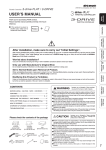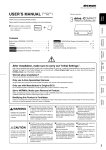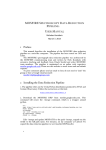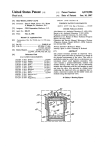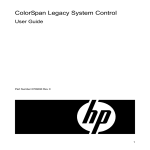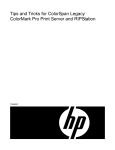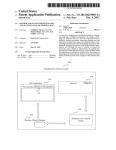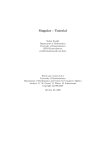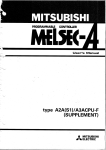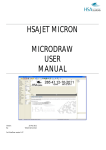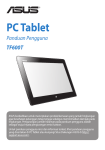Download Non-gary scale anti-aliasing method for laser printers
Transcript
United States Patent‘ 1191 [11] [45] Gilbert et al. METHOD FOR LASER PRINTERS [57] [76] Inventors: John M. Gilbert, 604 2nd St., NE, Minneapolis, Minn. 55413; Lawrence J. Lukis, 6366 150th St.; Leonard R. Steidel, 3473 Willow Beach Trail SW., both of Prior Lake, Minn. U ' ' [58] lutions in the horizontal and vertical dimensions is ac complished by selectively modifying the on and off states of pixels on either side of each vertical transition point along the horizontal components of raster lines representing the edges of the pixel representation of the H04N 1/21 image. A processor is provided with an ideal outline of """""""""""""""""""" 346/1 1_ the image and rasterizes the ideal outline of the image to ' """""""""""""""""""""" " ’ 358/2'96’ determine which pixels to turn on and which pixels to Field of Search ............... .. 346/108, 107 R, 76 L, “"11 Off in a frame buffer that Stores a Pixel representa 346/ 160, 11; 358/296, 300, 302, 298; 355/202 tion of the iamge to be printed by the laser printer. The ‘ References cued U.S. PATENT DOCUMENTS [56] 4,180,854 12/1979 4,682,189 ABSTRACT be printed by a laser printer having unequal pixel reso [21] Appl. N0.: 434,318 [22] Filed: Nov. 13, 1989 [52] Aug. 20, 1991 A non-gray scale anti-aliasing method for smoothing the horizontal components of the edges of an image to 55372 Int Cl 5 5,041,848 Primary Examiner-Mark J. Reinhart [54] NON-GARY SCALE ANTI-ALIASING [51] Patent Number: Date of Patent: modi?ed pixel representation in the frame buffer is then communicated to the laser printer such that the laser printer may print the smoothed image. Walden et al. .................... .. 364/200 7/1987 Purdy et al. ...................... .. 364/900 11 Claims, 5 Drawing Sheets 22; 1 I l SEMI“ POR A -/ T 1_x-e CONTROLUER FRAME co- l 18 INTERNAL CONTROLLER N’ 20 SWlTCH Ar'“ LASER A. 124 me /30 VJTDEQ JV‘ U S k 32 28/ k3‘ PC BOARD as L 36 A " 16 1 1 PRINT , ENGINE 52 LX-6 NEW 600x300 .---—7—-—1 /1—‘ / 26 US. Patent Aug. 20, 1991 OW Sheet 2 of 5 5,041,848 Om NM NM mm . .ME. mm EHOE<Q .MEem IPDE<A Wm WM Wm ‘w QOmI4xXO0Jw _ a US. Patent Aug. 20, 1991 Sheet 3 of 5 Fig. 3a PRIOR ART — Fig. 3b Hg. 4a PRIOR ART (4X) Fig. 4b 5,041,848 US. Patent Aug. 20, 1991 Sheet 4 of 5 5,041,848 Fig. 5 100 SET SCAN LINE-=0 a’ 102 SET PIXELCNT=O FILL=O it C FILL=F|LL+ URRENT PIXEL AREA THAT “106 SHOULD BE "ON" 11p TURN "ON" CURRENT PIXEL F|LL=FlLL-1 IS FILL >=1? 114 112 END OF RASTE'R LINE’? N0 INCREMENT PIXELCNT 1@ LAST NO SCAN LINE? INCREMENT - SCANUNE 120' ' US. Patent Aug. 20, 1991 Sheet 5 of 5 5,041,848 Fig. 6a lll'l-l l‘nl'l Hg. 60 62 61 F IHH I \l/ I | I m?I HIIHHIIH I| l A llll lml 60 1 5,041,848 2 capable of implementing such gray-scale techniques. In larger and more expensive laser printers, the problems NON-GARY SCALE ANTI-ALIASING METHOD FOR LASER PRINTERS associated with aliasing and non-smooth edges may be resolved by using higher pixel resolutions in these print TECHNICAL FIELD This invention pertains to methods of rasterization and fill techniques used to create images to be printed ers. In the smaller, inexpensive laser printers used with desktop publishing systems, this approach is not used by laser printers. More particularly, this invention per While the prior art printer controller cards have al because of the associated increase in cost. tains to a non-gray scale anti-aliasing method for 10 lowed users of desktop publishing systems to signi? cantly increase the quality of their printed outputs by smoothing the horizontal edges of an image to be increasing the horizontal resolution of the existing laser printed by a laser printer having unequal resolutions in printers used with such systems, it would be advanta the horizontal and vertical dimensions. geous to be able to improve the quality of the outline BACKGROUND ART edges of a character or image that occur in a near hori zontal orientation, particularly if such an improvement In recent years, the use of smaller, inexpensive laser printers with personal computers has created an entirely - could be accomplished without any additional hard new industry referred to as desktop publishing. Desktop publishing systems offer user the ability to format and troller cards. ware that would increase the cost of such printer con~ print documents having complicated layouts using characters that have a variety of different fonts and type 20 sizes. While desktop publishing systems represent a signi?cant advance in the art of publishing, the standard resolution of the laser printers used with such systems SUMMARY OF THE INVENTION In accordance with the present invention, a non-gray scale anti-aliasing method for smoothing the horizontal components of the edges of an image to be printed by a (typically a 300x300 dpi Canon CX or SX-based laser laser printer having unequal pixel resolutions in the printer, eg a HP LaserJet Series II printer) was too 25 horizontal and vertical dimensions is accomplished by poor to compete with traditional phototypesetting sys selectively modifying the on and off states of pixels on tems. either side of each vertical transition point along the In an effort to improve the quality and speed of the horizontal components of raster lines representing the smaller, inexpensive laser printers used with desktop edges of the pixel representation of the image. The publishing systems, a variety of printer controller cards 30 method of the present invention may be used by a pro have been introduced that may be installed either in the laser printer or in the personal computer. Certain of the printer controller cards that are installed directly in the personal computer increase the quality and speed of the cessor means that is provided with an ideal outline of the image and rasterizes the ideal outline of the image using the processor means to determine which pixels to laser printers by using a separate co-processor and page 35 turn on and which pixels to turn off in a frame buffer frame buffer to create a. pixel representation of the image to be printed on the laser printer. This image is then printed from the pixel representation in the page frame buffer by directly controlling the modulation of the laser in the print-engine of the laser printer. An example of such a printer control card is the LX6 Pro fessional printer controller cards available from Laser Master Corporation, Eden Prairie, Minn., the assignee of the present invention. In some of the prior art printer controller cards, such as the LX6 Professional, it is possible to increase the memory means that stores a pixel representation of the image to be printed by the laser printer. The method of the present invention produces a modi?ed pixel repre sentation in the frame buffer means that is communi 40 cated to the laser printer such that the laser printer may print the smoothed image. In essence, the present invention smooths each of the vertical transition points between horizontal raster lines by adding and subtracting pixels around this transition point. The pixel representation created in the frame the modulation of the laser in the print-engine of the buffer for each horizontal raster line is used to control the laser i the laser printer. When the laser is turned on in response to an “on" pixel, a generally circular laser laser printer. By doing so, the LX6 Professional printer beam image is re?ected on the print drum of the print of the pixel rrsolution of the laser printer to 600x300 dpi and 1000 X 400 dpi, depending upon the type of laser printer. This increase in horizontal resolution signi? charge elements attract and pick up the toner that is then transferred to the sheet of paper. Although the horizontal resolution of the laser printer by controlling controller cards can increase the horizontal component 50 engine to transfer charge elements to the drum. The cantly improves the quality of the resulting printed image, particularly for pixel transition points along the outline edges of a character or image that occur in the vertical or near vertical orientation. Unfortunately, the pixel elements are thought of as square or rectangular shapes, in actuality, the edges of the pixels typically 55 bleed into one another to a signi?cant degree. This is due to the laser power function at the surface increased horizontal resolution does little to improve the quality of the outline edges of a character or image of the drum which typically decreases with the distance from the center of the focal point over a generally cir cular or elliptical area covering a space larger than the that are near horizontal in slope. theoretical rectangular pixel. Therefore the total laser The noticeability and appearance of such vertical pixel transition points is typically referred to as aliasing that results in jagged or stairstep edges of the character or image outline oriented generally in the horizontal direction. Traditionally, anti-aliasing techniques incor porating a gray-scale approach have been used in video displays to resolve this type of problem. Unfortunately, laser printers are binary imaging devices and are not energy impinging upon a given point on the drum may have components contributed by more than a single sweep of the laser beam. This effect will be especially pronounced in the region between the centerlines of 65 two adjacent raster lines. The total laser power imping ' ing on a given point determines the resulting amount of charge on the drum at that point which in turn deter mines whether toner will stick to that point or not. 3 5,041,848 4 printed by a laser printer having unequal resolutions in It is believed that the present invention takes advan tage of the physics of this process at the higher laser the horizontal and vertical dimensions. modulation rate generated by the printer controller Another objective of the present invention is to in crease the quality of the image printed using a printer cards to create the desired smoothing of the transition points. For edges in the near horizontal raster line just below the outline edge, some of those charge elements overlap onto the next horizontal raster line that contains the outline edge with the transition point. In that next horizontal line, the application of the laser in response controller card without increasing the amount of frame buffer memory required to store the pixel representa tion of that image. A further objective of the present invention is to increase the quality of the image printed using a printer to the modi?ed pixel representation briefly turns the a. . O controller card without requiring additional hardware laser on, for example, for a selectively modi?ed “on" circuitry on the printer controller card or the print pixel prior to the transition point. The duration of this pulse of laser energy is insuf?cient to charge this pixel engine of the laser printer. location enough to attract toner, however in the over lap region, suf?cient charge may be added to the charge already deposited by the lower raster linen to alter the boundary of the region in which toner sticks to the drum. Thus, in effect the location of a horizontal edge of the image may be controlled to within less than the width of a full pixel. The most signi?cant advantage of using the smooth ing method of the present invention in conjunction with a laser printer having unequal resolutions in the hori zontal and vertical dimensions is that quality of the printed image is nearly equivalent to that of an image printed on a much higher resolution printer having equal resolutions in the horizontal and vertical dimen sion. Although the resolution of the laser printer is 600x 300 dpi, the image produced using the method of t. . 5 Still another objective of the present invention is to implement the smoothing method of the present inven tion during the ?ll process of theprasterization of the pixel representation of the image without requiring any post-rasterization processing or circuitry to accomplish the smoothing of the images. These and other objectives of the present invention will become apparent with reference to the drawings, the detailed description of the preferred embodiment and the appended claims. DESCRIPTION OF THE DRAWINGS FIG. 1 is a block diagram of laser printing system having a printer controller card for generating an image to be printed by a laser printer having unequal resolu tions in the horizontal and vertical dimensions. FIGS. 20, 2b and 2c are schematic pixel representa the present invention will more closely resemble 30 tions of a shallow horizontal outline edge for two prior 600x600 dpi print quality. An additional advantage is art pixel representations and the modi?ed pixel repre that this increase in quality is accomplished using the sentation in accordance with the present invention. modi?ed pixel representation in a frame buffer memory FIGS. 30 and 3b are actual sample printouts of the that occupies half of the space of the frame buffer mem same ?lled polygon having a shallow horizontal edge ory required to produce an equivalent pixel representa using a prior laser printing system and a laser printing tion for a higher resolution printer. As a result less system incorporation the present invention. memory is needed for the printer controller card and FIGS. 4a and 4b are the same sample printouts as the printer controller card is less expensive. shown in FIGS. 30 and 312 shown in 4X scale. In the preferred embodiment of the present invention, FIG. 5 is a ?owchart showing the steps of the pre the smoothing of the horizontal components of the 40 ferred embodiment of the smoothing method of the edges of the ideal outline is accomplished during the fill present invention. process as each horizontal raster line is being rasterized. FIGS. 6a, 6b and 6c are pixel representation of the Typically, the horizontal raster lines are processed from outline of a ?lled polygon showing the ideal outline top to bottom in the frame buffer and the pixels are alone, the ideal outline as ?lled using a prior laser print processed from left to right. As each horizontal scan 45 ing system and the ideal outline as ?led using a laser line of an ideal polygon outline is being rasterized, the printing system incorporating the present invention. processor accumulates a fill value that represents the area of each pixel inside of the ideal outline that should be turned “on” or ?lled. If the processor determines that the area of the ?ll value is greater than the area of a pixel, the pixel presently being processed is turned “on“ and the area of a pixel is subtracted from the ?ll value. In this embodiment, the ?ll value acts like a run DESCRIPTION OF THE PREFERRED EMBODIMENTS Referring now to FIG. 1, a typical desktop publishing system 10 having the printer controller card that exe cutes the software that comprises the preferred embodi ment of the present invention will be described. The ning accumulator with the carry out of the accumulator hardware for the desktop publishing system 10 is com being used to determine whether the pixel presently 55 prised of a personal computer 12 connected with a being processed should be turned “on”. Any number of small, inexpensive laser printer 14. The personal com methods can be used to determine the amount of the ?ll value for each pixel. For example, instead of calculating puter 12 may be any one of a variety of personal com puters such as an IBM PC, XT/AT, 386, or PS/Z, avail the entire area inside the ideal outline, the height of the able from International Business Machines, Armonk, midpoint of the segment of the ideal outline in the pixel 60 N.Y., or an Apple Macintosh, available from Apple or the height of the intersection of the ideal outline with Computers, Inc. Cupertino, Calif. The personal com the right or left edge of the pixel could be used to esti puter 12 may be provided with a desktop publishing mate the value of the area inside the ideal outline. A software package, such as Ventura Publisher, available similar method may be used to process edges and transi from Xerox Corporation, PageMaker, available from tions which occur in the near vertical direction. Aldus Corporation, or GEM Desktop Publisher, avail A primary objective of the present invention is to able from Digital Research, Inc. The laser printer 14 provide a non-gray scale anti-aliasing method for smpothing the horizontal edges of an image to be may be any type of Canon CX or SX laser printer such as the HP LaserJet Series II available from Hewlett 5 5,041,848 6 24 via a video cable 38. An internal switch 40 in the laser printer 14 allows the printer controller 30 to over Packard, the LaserWriter, available from Apple Com puter, Inc., or the Canon LBPS-III, available from Canon. ride the internal controller 20 of the laser printer and directly modulate the laser 24. It is this direct modula tion of the laser 24 that allows the printer controller 30 to increase the horizontal resolution of the laser printer 14. For a more detailed explanation of the operation the LX6 printer controller 30, reference is made to the LX In normal operation without a printer controller card, the personal computer 12 includes a main PC mother board 16 and a serial port 18 through which the personal computer 12 communicates with the internal controller 20 of the laser printer 14. The computer 12 sends a serial bit stream to the laser printer 14 over an RS-232-C serial interface 22 in the form of various com User Guide, which is incorporated herein by reference mands and data that represent the image to be printed by the laser printer 14. The internal controller 20 de codes the serial bit stream and generates the control signals that will be supplied to the laser 24 to drive the Referring now to FIGS. Za-ec, the differences be tween the smoothing method of the present invention and the prior art will be described. Each of FIGS. 20-20 show a single raster horizontal raster line 50 comprised of a plurality of pixels 52 that may either be white (“ofl") or black (“on”). Also shown is the ideal line 54 and is available from LaserMaster Corporation. print engine 26 that creates the printed images corre sponding to the various commands and data received by that forms the outline of the image or character to be printed. In this case, the ideal line 54 is the worst case the internal controller. For a more detailed explanation of the internal operation of the laser printer 14, refer version of a shallow horizontal line for the edge of an ence is made to the LaserJet II Printer User’s Manual, Edition 1, available from Hewlett-Packard. 20 outline. The prior art is represented by the 300>< 300 dpi Because of the inherent limitations on the speed at raster line 50 generated by the internal controller 20 as which the commands and data can be transferred over shown in FIGS. 2al , and the 600x 300 dpi raster line 50 the serial interface and decoded by the internal control generated by the LX6 controller 30 without using the method of the present invention. It can easily be seen that there is a very de?nite and sharp vertical transition ler 20, the page throughput for the laser printer 14 is typically very low, 6 pages per minute or less, depend ing upon the formatting and type of information being printed. To solve this problem and to simultaneously increase the quality and performance features of the laser printer, various printer controller cards 30 have been introduced into desktop publishing systems, such as the LX6 Professional, available from LaserMaster point 56 at the edges of the two pixels adjacent the point where the ideal line 54 crosses the midway vertical height of the pixels 52. This de?ne and sharp vertical transition point 56 creates jagged edges or “steps” that are visible to the human eye as shown for example in FIGS. 30 and 4a. In contrast, the raster line 50 shown in Corporation, Eden Prairie, Minn. The printer control FIG. 2c that is generated by the LX6 controller 30 using ler card 30 of the preferred embodiment is located in the the method of the present invention does not have such personal computer 12 and communicates directly with a sharp black-and-white vertical transition point 56. By selectively turning on pixels in the raster line 50 to the the PC mother board 16 via an internal bus 28. It will be recognized, however, that the printer controller board 30 may be located in the laser printer 14 or that the present invention may be implemented within the inter nal controller 20 of the laser printer 14. left of the transition point 56 and turning off pixels to the right of the transition point 56, the present invention smooths the transition point 56 as seen by the human eye as shown for example in FIG. 3b and 4b. Vertical In the preferred embodiment, the printer controller 40 and near vertical edges are smoothed in much the same card 30 is an LX6 Professional printer controller card fashion. It will be understood that the smoothing of transitions may also be effective when operating at selected to match the particular type of laser printer 14 being used in the desktop publishing system 10. The equal resolutions, although the preferred embodiment of the present invention is most successful with unequal LX6 controller consists of a frame buffer 32, a co processor 34 and a video interface 36. The co-processor 45 horizontal and vertical dimensions. 34 receives the various commands and data represent ing the image to be printed from the PC mother board 16 via the bus 28. Because the bus 28 is a parallel bus, the transfer rate is much faster than for the serial port 18. The co-processor 34 decodes the commands and infor mation and produces a mathematically pure ideal out line corresponding to a ?lled polygon that will repre sent each image or character to be printed. The 00 processor 34 may also aid the personal computer 12 in a rendering lines, graphics and characters as determined In the preferred embodiment, the smoothing method of the present invention is applied by the co-processor 34 as it is generating each horizontal raster line 50 to be stored in the frame buffer 32. Typically, the horizontal raster lines 50 are processed from top to bottom in the frame buffer 32 and the pixels 52 are processed from left to right, although it will be recognized that the raster lines 50 and pixels 52 may be processed in any direction so long as the processing is consistent throughout an entire page in the frame buffer 32. As the decision is by the particular application software package cur made whether to turn a pixel 52 on or off, a ?ll value rently being run on the personal computer 12. Once the ideal outline is generated, it is then ?lled in or “rasterized” to produce a pixel representation of the image to be printed that is stored in the memory of the frame buffer 32. Any number of known ?ll techniques or algorithms may be used to ?ll in the pixels inside of representing the area between edge of the ideal outline 54 and the edge of the pixel 52 is accumulated. When the outline, depending upon how overlapping images are to be handled. When the laser printer 14 is ready to print a page or “frame” worth of images, the pixel rep resentation in the frame buffer 34 is transferred to the laser printer 14 via the video interface 36 in the printer controller 30 that communicates directly with the laser the ?ll value is equal to or greater than the total area of a single pixel, the pixel presently being operated on is turned “on" and the area of a single pixel is subtracted from the ?ll value. In this embodiment, the ?ll value acts like a running accumulator with the carry out of the accumulator being used to determine whether the pixel presently being processed should be turned “on”. Any number of methods can be used to determine the amount of the ?ll value for each pixel. For example, instead of calculating the entire area inside the ideal 7 5,041,848 outline, the height of the midpoint of the segment of the ideal outline in the pixel or the height of the intersection 8 inside the ideal outline 54 (below the line segment 60) is l/20th the area of an entire pixel 52. For pixel 62, the area is 2/20th, etc. By accumulating the values for each of the ideal outline with the right or left edge of the pixel could be used to estimate the value of the area of the pixels in line segment 60, it can be seen that at inside the ideal outline. Similar algorithms may be used pixel 66, the value of FILL=2l/2O (l/20+2/20+3/20+4/20+5/20+6/20). Conse to process short vector and curves in order to apply the smoothing method of the present invention to a variety quently, pixel 66 is turned on and FILL now equals l/20. The process is continued and at pixel 69, FILL is of different shapes. Referring now to FIGS. 5 and 6, the operation of the again greater than or equal to 1 and FILL=25/2O preferred method of the present invention will be de scribed in greater detail. At Start 100, an ideal outline 54 (l/20+7/20+8/20+9/20). as shown in FIG. 60 has been determined based upon the outline of the image or character to be printed. It invention is described with respect to the ?lling or rast should be noted that, in general, the characters or im ages to be printed can be thought of as ?lled polygons, or combinations of ?lled polygons. It is also possible to as well as to any ?lled polygon where it is desired to use the method of the present invention with ideal out lines 54 whose edges are in the form of arcs and curves, Although the preferred embodiment of the present erizing of an ideal outline, it should be noted that the method of the present invention may be applied equally - smooth the horizontal components of the polygon when printing the image out on a printer having unequal hori zontal and vertical resolutions. In this situation, the rather than straight lines. At 102, the value SCAN ideal outline could be assumed to be a series of lines LINE representing the number of horizontal scan lines 20 segments constructed around the outermost edges of 50 in the frame buffer 32 is set equal to zero. At 104, the value PIXELCNT representing the number of pixels 52 the horizontal components of the ?lled polygon. Although the description of the preferred embodi~ in a scan line 50 and the value FILL representing the ment has been presented, it is contemplated that various area of a single pixel 52 are also set to zero. In this changes could be made without deviating from the embodiment, the area of a single pixel 52 is assumed to 25 be one for simplicity of explanation. It will be under stood that the value of FILL may be determined using any of the methods discussed above for estimating the area of the pixel 52 inside the ideal outline 54. At this point, the software program that is imple menting the method of the present invention on the co-processor 34 of the controller card 30 is ready to spirit of the present invention. Accordingly, it is in tended that the scope of the present invention be dic tated by the appended claims rather'than by the descrip tion of the preferred embodiment. We claim: 1. A method for smoothing the edges of an image to be printed by a binary imaging printer having unequal start rasterizing the ideal outline 54 to produce the hori pixel resolutions in the horizontal and vertical dimen should be “on” because it is inside the ideal ‘outlet 54 is added to FILL. At 108, the value of FILL is compared the image; rasterizing the ideal outline of the image using the to see if the current pixel should be turned on. If so, at processor means to determine which pixels to turn on and which pixels to turn off in a frame buffer memory means that stores a pixel representation of sions, comprising the steps of: zontal raster lines 50 that will be stored in the frame providing a processor means with an ideal outline of buffer 32. At 106, the value of the current pixel area that 35 110, the current pixel is turned on and the value of the area of a single pixel (1) is subtracted from FILL. At 112, a check on PIXELCNT to see if processing is at the end of a raster line 54. If not, then PIXELCNT is incremented and the loop is reentered at 106. If it is the end of a raster line, then a check on SCANLINE is made at 116 to see if this is the last raster line in the 45 frame buffer 32. If not, the SCANLINE is incremented at 118 and the loop is reentered at 104. When the frame the image to be printed by the printer; smoothing the edges of the digital outline by selec tively modifying the on and off states of pixels on either side of each vertical transition point along the horizontal components of the edges of the pixel representation of the image to produce a modi?ed pixel representation in the frame buffer means; and communicating the modi?ed pixel representation buffer 32 has been completely rasterized, then control is stored in the frame buffer memory means to the returned from the software program via RETURN 120. printer such that the printer may print the To understand how the preferred embodiment of the 50 smoothed image. present invention would work in practice and how it 2. A method of smoothing the horizontal components compares with the prior art, reference is made ‘0 FIGS. of the edges of an ideal outline of an image to be printed 6b and 6c. It will be noted that the pixels 52 in these by a binary imaging printer having unequal pixel resolu ?gures are rectangular indicating the non-uniform hori zontal and vertical resolutions of the printer used to 55 tions in the horizontal and vertical dimensions, compris ing the steps of: print these images. Using the line segment 60 as an rasterizing the ideal outline of the image using a pro example, it will be seen that the line segment 60 is one cessor means to process a plurality of horizontal pixel high and 20 pixels long. In this case, the transition raster lines comprised of a plurality of pixels, each point 56 using the prior art rasterization methods is 10 pixels in from ether end of the line segment 60. All of 60 pixel having a given total area, to form a pixel the pixels to the left of transition point 56 are “off’ and representation of the image in a frame buffer, the all of the pixels to the right of transition point 56 are rasterizing being performed to smooth the horizon “on”. In contrast, in FIG. 6c, the pixels 52 along the line tal components of the ideal outline of the image by segment 60 are selectively turned off and on around the performing the following steps for each of the transition point 56. For purposes of estimating the area 65 horizontal raster lines; of each pixel 52 to be turned on, an assumption is made accumulating a ?ll value representing the area in that the increase in area for each pixel is represented by side the ideal outline for the pixel currently being the slope of the line: l/20. Hence, for pixel 61, the area processed; 9 5,041,848 area; and area; and if the ?ll value is greater than the total area, turning if the ?ll value is greater than the total area, turning on the pixel currently being processed and sub on the pixel currently being processed and sub tracting the total area from the ?ll value. 8. The method of claim 2 wherein the step of accumu lating a ?ll value representing the area inside the ideal tracting the total area from the ?ll value. 3. The method of claim 1 wherein the processor means is comprised of a printer control card operably connected with a computer, the printer control card including a co-processor for rasterizing the ideal outline of the image, the frame buffer memory means for stor ing the pixel representation of the image to be printed by the printer, and a video interface for communicating the modi?ed pixel representation stored in the frame buffer means to the printer. 4. The method of claim 3 wherein the ideal outline is generated by the co-processor in response to commands and data received from the computer. 10 determining if the ?ll value is greater that the total determining if the ?ll value is greater than the total outline for the pixel currently being processed is accom plished by calculating the entire area inside the ideal outline. _ 9. The method of claim 2 wherein the step of accumu lating a ?ll value representing the area inside the ideal 15 outline for the pixel currently being processed is accom plished by estimating the area inside the ideal outline based upon the height of the midpoint of a segment of the ideal outline that crosses the pixel currently being processed. 10. The method of claim 2 wherein the step of accu mulating a ?ll value representing the area inside the 5. The method of claim 1 wherein the binary imaging 20 ideal outline for the pixel currently being processed is accomplished by estimating the area inside the ideal printer is a laser printer including a laser and a marking outline based upon the height of the left height of the engine. left edge of a segment of the ideal outline that crosses 6. The method of claim 5 wherein the step of commu the pixel currently being processed. nicating the modi?ed pixel representation to the printer is accomplished by using a video interface to directly modulate the laser in the laser printer. 11. The method of claim 2 wherein the step of accu mulating a ?ll value representing thearea inside the ideal outline for the pixel currently being processed is 7. The method of claim 1 wherein the step of smooth accomplished by estimating the area inside the ideal outline based upon the height of the right edge of a segment of the ideal outline that crosses the pixel cur ing the edges of the digital outlines is accomplished by: accumulating a ?ll value representing the area inside rently being processed. the ideal outline for the pixel currently being pro t cessed; 35 45 55 65 t i i i












